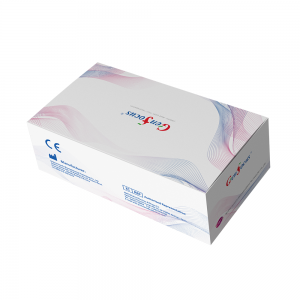
HPV Antigen Rapid Test
Introduction
Human Papillomavirus (HPV) is one of the most common sexually transmitted infections globally, with over 200 known types. While many HPV infections clear on their own, persistent infections with certain high-risk types can lead to cervical cancer and other HPV-related cancers. Early detection of HPV infections is crucial for effective management and prevention of associated health risks. HPV antigen test kits have emerged as valuable tools in this regard, offering simplicity, affordability, and potential for widespread use.
Understanding HPV and Its Impact
Human Papillomavirus (HPV) infects epithelial cells, primarily affecting the skin and mucous membranes of the anogenital region, mouth, and throat. It is highly prevalent worldwide, with an estimated 80% of sexually active individuals contracting HPV at some point in their lives. While most infections resolve without intervention, persistent infection with high-risk HPV types, such as HPV 16 and HPV 18, can lead to the development of cervical cancer, as well as cancers of the anus, penis, vagina, vulva, and oropharynx.
Benefits of HPV Antigen Test Kits
- Ease of Use: HPV antigen test kits are designed for simplicity, making them suitable for use in various settings, including clinics, doctor’s offices, and even home-based testing.
- Rapid Results: The quick turnaround time of HPV antigen tests allows for timely diagnosis and immediate counseling or treatment initiation.
- Cost-Effectiveness: Compared to DNA-based tests like PCR (Polymerase Chain Reaction), HPV antigen test kits are generally more affordable, which can facilitate broader access to screening.
- Potential for Point-of-Care Testing: Some HPV antigen test kits are designed for point-of-care use, enabling testing and results interpretation in resource-limited settings or remote areas.
How to Use an HPV Antigen Test Kit: Step-by-Step Guide
Using an HPV antigen test kit involves several steps, including sample collection, preparation, and interpretation of results. Here’s a detailed step-by-step guide:
- Step 1: Familiarize Yourself with the Kit: Read the manufacturer’s instructions thoroughly before beginning the test.
- Step 2: Sample Collection: Collect the appropriate sample (cervical cells, anal cells, etc.) using the provided swab or brush.
- Step 3: Prepare the Sample: Follow instructions to prepare the sample by placing it in a buffer or solution provided with the kit.
- Step 4: Perform the Test: Apply the prepared sample to the designated area of the test device or cassette.
- Step 5: Wait for Results: Allow the specified time for the test to develop, avoiding movement of the test device during this period.
- Step 6: Interpret Results: Read and interpret the test results according to the manufacturer’s guidelines, which typically indicate positive, negative, or invalid results.
- Step 7: Dispose of Materials: Dispose of used materials according to local regulations, especially biohazard waste disposal
Comparison with Other Screening Methods
- Pap Smear (Cytology): Traditional Pap smears detect abnormal cervical cells rather than HPV itself and may miss early-stage infections.
- HPV DNA Tests: These tests detect HPV DNA sequences, providing high sensitivity but requiring specialized laboratory equipment and trained personnel
- Accuracy and Sensitivity: HPV antigen test kits have shown varying degrees of sensitivity and specificity compared to DNA-based tests, influencing their utility in different screening
Global Impact of HPV Antigen Test Kits
The introduction of HPV antigen test kits has had significant implications for global public health efforts, particularly in low-resource settings where access to traditional screening methods may be limited. By facilitating early detection and treatment initiation, these kits contribute to reducing the burden of HPV-related cancers and improving health outcomes globally.
Conclusion
HPV antigen test kits represent a valuable addition to the toolkit for HPV screening and prevention, offering simplicity, affordability, and rapid results. While they have demonstrated effectiveness in various settings, ongoing research and development are essential to address challenges and optimize their utility. By expanding access to reliable HPV testing, these kits contribute to early detection, timely intervention, and improved health outcomes globally.








-300x209.jpg)
-300x209.jpg)
